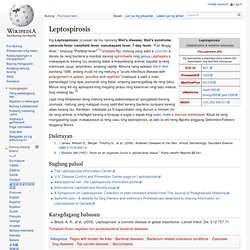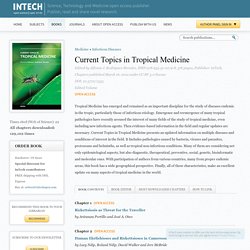

Leptospirosis - Wikipedia. Lipat ning kikilalanan deng metung kareng pekamaleparan pangakalat kareng zoonosis, metung yang malagad mung sakit ibat kareng bacteria cumpara kareng aliwa kareng tau.

Keraklan, mikakalat ya iti kapamilatan ning danum a mirinan imi da reng animal, a mitatagkil kareng e kinayap a sugat o aspak king balat, mata o mucous membrane. Kilual da reng mangapaling lugal, makapanaun la reng casu ning leptospirosis, at lalto la reti neng Agosto anggang Setiembre/Febrero anggang Marzo. Dalerayan Jump up ↑ James, William D.; Berger, Timothy G.; et al. (2006). Andrews' Diseases of the Skin: clinical Dermatology. Suglung palual Karagdagang babasan. OMS - 2009 - The Global Burden of Leptospirosis. The Global Burden of Leptospirosis What do we know?

Leptospirosis is a zoonotic disease caused by bacteria of the genus Leptospira. It is most commonly spread via water contaminated with urine from infected animals, but contaminated food or soil can also act as vehicles for the disease. The main animal reservoirs are rodents, livestock and dogs. Disease in humans can vary from mild flu-like illness to serious disease.
Although Leptospirosis can occur worldwide, there are a number of risk factors associated with the disease. Regional Medical Research Centre/Port Blair/India Did you know? The actual incidence of Leptospirosis in Hawaii is estimated to be double the reported incidence. What do we still need to know? Very little is currently known regarding the true incidence of Leptospirosis. Share. Sheep a major source of leptospirosis infection. The changing profile of victims of leptospirosis and the high number of cases amongst Hawke’s Bay meat workers have prompted a co-operative study into the disease between Massey University’s EpiCentre and meat company PPCS.

The research was carried out in February and March at the PPCS Takapau plant. Thirteen of 15 patients admitted to the ICU at Hawke’s Bay Hospital suffering from leptospirosis from 1999-2005 were employed as meat workers or inspectors. Blood samples and interviews were conducted with 242 volunteers. Twenty-three, (9.5 percent), tested positive to antibodies for Leptospira serovars pomona (13) or hardjo-bovis (9) and one tested positive to both. Dr Jackie Benschop says these workers had occupational exposure to sheep only. The results are preliminary and the EpiCentre leptospirosis team, led by Associate Professor Cord Heuer, still has more work to do on the data collected. Veterinary World - Volume 2 No.7 July 2009 Leptospriosis in sheep and its diagnosis. Shivraj, Dr.; Venkatesha, M.D.; Sanjukta, Rajkumari; Sripad, K.; SanjeevKumar, Dr.; Chandranail, B.M. and Renukaprasad, C. (2009) Leptospriosis in sheep and its diagnosis.Veterinary World, 2 (7). pp. 263-264.

ISSN 0972-8988 Full text available as: The present study was carried out to screen or detect the leptospirosis in the migratory flocks of sheep in Karnataka. A total of 60 blood, tissue and urine samples were collected from the migratory sheep flock in the area of Shimogga and Belgaum districts of Karnataka with clinical manifestation. The samples were subjected to screening for leptospirosis by Dark Field Microscopy (DFM), Polymerase chain reaction (PCR), isolation and identification studies. Archive Staff Only: edit this record. INDIAN JOURNAL OF MEDICAL MICROBIOLOGY - 2006 - Leptospirosis: Current status and future trends.
Leptospirosis: Current status and future trends RA Hartskeerl Department of Biomedical Research, Royal Tropical Institute (KIT), Meibergdreef 39, 1105 AZ Amsterdam, Netherlands Correspondence Address:R A HartskeerlDepartment of Biomedical Research, Royal Tropical Institute (KIT), Meibergdreef 39, 1105 AZ Amsterdam Netherlands.

Veterinary World - Vol.1 No.6 June 2008 Leptospirosis : a re-emerging disease. INTECH - AVRIL 2012 - Zoonosis. Au sommaire: Insights into Leptospirosis, a Neglected Disease. Edited by Jacob Lorenzo-Morales, ISBN 978-953-51-0479-7, 448 pages, Publisher: InTech, Chapters published April 04, 2012 under CC BY 3.0 licenseDOI: 10.5772/2125 Edited Volume Zoonotic diseases are mainly caused by bacterial, viral or parasitic agents although "unconventional agents" such as prions could also be involved in causing zoonotic diseases.

Many of the zoonotic diseases are a public health concern but also affect the production of food of animal origin thus they could cause problems in international trade of animal-origin goods. A major factor contributing to the emergence of new zoonotic pathogens in human populations is increased contact between humans and animals. This book provides an insight on zoonosis and both authors and the editor hope that the work compiled in it would help to raise awareness and interest in this field. INTECH - MARS 2012 - Au sommaire: Leptospirosis: Epidemiologic Factors, Pathophysiological and Immunopathogenic. Edited by Alfonso J.

Rodriguez-Morales, ISBN 978-953-51-0274-8, 576 pages, Publisher: InTech, Chapters published March 16, 2012 under CC BY 3.0 licenseDOI: 10.5772/1335 Edited Volume Tropical Medicine has emerged and remained as an important discipline for the study of diseases endemic in the tropic, particularly those of infectious etiology. Nutritional Care of Preterm Infants - The Developing Intestinal Microbiome: Probiotics and Prebiotics. Abstract The microbes in the human intestinal tract interact with the host to form a ‘superorganism'.

The functional aspects of the host microbe interactions are being increasingly scrutinized and it is becoming evident that this interaction in early life is critical for development of the immune system and metabolic function and aberrations may result in life-long health consequences. Evidence is suggesting that such interactions occur even before birth, where the microbes may be either beneficial or harmful, and possibly even triggering preterm birth. Mode of delivery, use of antibiotics, and other perturbations may have life-long consequences in terms of health and disease. Manipulating the microbiota by use of pro- and prebiotics may offer a means for maintenance of ‘healthy' host microbe interactions, but over-exuberance in their use also has the potential to cause harm. References Turnbaugh PJ, et al: The human microbiome project. Author Contacts.